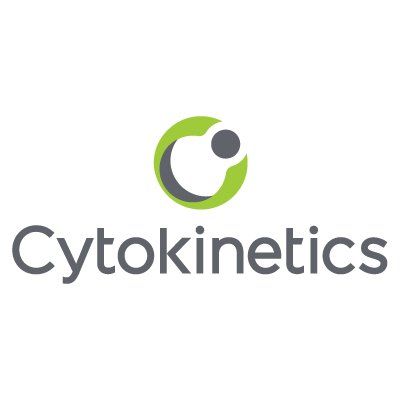预约演示
更新于:2025-05-07

Cytokinetics, Inc.
更新于:2025-05-07
概览
标签
心血管疾病
眼部疾病
神经系统疾病
小分子化药
疾病领域得分
一眼洞穿机构专注的疾病领域
暂无数据
技术平台
公司药物应用最多的技术
暂无数据
靶点
公司最常开发的靶点
暂无数据
| 排名前五的药物类型 | 数量 |
|---|---|
| 小分子化药 | 16 |
关联
26
项与 Cytokinetics, Inc. 相关的药物作用机制 nAChRα4&β2激动剂 |
原研机构 |
非在研适应症 |
最高研发阶段批准上市 |
首次获批国家/地区 美国 |
首次获批日期2006-05-10 |
作用机制 心肌肌球蛋白复合体抑制剂 |
在研机构 |
非在研适应症- |
最高研发阶段申请上市 |
首次获批国家/地区- |
首次获批日期- |
作用机制 L-type calcium channel阻滞剂 |
在研适应症 |
非在研适应症- |
最高研发阶段申请上市 |
首次获批国家/地区- |
首次获批日期- |
56
项与 Cytokinetics, Inc. 相关的临床试验CTR20250984
优化再灌注以改善结局和神经功能(ORION):一项 评价JX10治疗晚时间窗急性缺血性卒中的有效性和安全性的 多中心、双盲、安慰剂对照、随机、平行组、2/3期研究
评估AIS发病后4.5至24小时内,符合静脉溶栓条件的患者在标准治疗基础上使用JX10在良好结局方面是否优于安慰剂
开始日期2025-04-02 |
申办/合作机构 |
NCT06793371
A Multi-Center, Randomized, Double-Blind, Placebo-Controlled Study to Evaluate the Safety, Tolerability, Pharmacokinetics, and Pharmacodynamics of CK-4021586 in Adults with Symptomatic Heart Failure with Preserved Ejection Fraction
This is a Phase 2 dose-finding study in adult participants with symptomatic HFpEF.
开始日期2025-01-01 |
申办/合作机构 |
NCT06736574
A Multi-Center, Double-Blind, Randomized, Placebo-Controlled Trial to Assess Efficacy and Safety of Omecamtiv Mecarbil in Patients With Symptomatic Heart Failure With Severely Reduced Ejection Fraction (COMET-HF)
The purpose of this study is to find out if the investigational drug called omecamtiv mecarbil can reduce the risk of the effects of heart failure, like hospitalization, transplantation, or death in patients with heart failure and severely reduced ejection fraction.
开始日期2024-12-19 |
申办/合作机构 |
100 项与 Cytokinetics, Inc. 相关的临床结果
登录后查看更多信息
0 项与 Cytokinetics, Inc. 相关的专利(医药)
登录后查看更多信息
168
项与 Cytokinetics, Inc. 相关的文献(医药)2024-12-31·Journal of Medical Economics
The prognostic value of peak oxygen uptake in obstructive hypertrophic cardiomyopathy: a literature review to inform economic model development
Review
作者: Butzner, Michael ; Kinyik-Merena, Csilla ; Davison, Niall ; Aguiar, Magda ; Shreay, Sanatan ; Masri, Ahmad
2024-11-12·Circulation
Abstract 4139790: Efficacy and Safety of Omecamtiv Mecarbil in Heart Failure with Reduced Ejection Fraction According to Age: the GALACTIC-HF Trial
作者: Malik, Fady ; Lu, Henri ; Felker, Gary ; Solomon, Scott ; Metra, Marco ; Diaz, Rafael ; McMurray, John ; Teerlink, John ; Vaduganathan, Muthiah ; Heitner, Stephen ; Claggett, Brian
2024-11-12·Circulation
Abstract 4140102: Changes in EQ-5D-5L with Aficamten in Obstructive Hypertrophic Cardiomyopathy (oHCM): the SEQUOIA-HCM Trial
作者: Olivotto, Iacopo ; Coats, Caroline ; Masri, Ahmad ; Malik, Fady ; Butzner, Michael ; Abraham, Theodore ; Claggett, Brian ; Veselka, Josef ; Wohltman, Amy ; Hagege, Albert ; Kwong, Raymond ; Maurer, Mathew ; maron, Martin ; Kulac, Ian ; Meng, Lixin ; Januzzi, James ; Schulze, Christian ; Shreay, Sanatan ; Nassif, Michael ; Jacoby, Daniel ; Garcia-Pavia, Pablo ; Spertus, John ; Heitner, Stephen ; Kupfer, Stuart ; Barriales-Villa, Roberto
556
项与 Cytokinetics, Inc. 相关的新闻(医药)2025-05-02
Cytokinetics\' addition of a REMS plan constituted a \"major\" application amendment, triggering a three-month delay.\n To REMS, or not to REMS.That, apparently, was the question for Cytokinetics, which has seen any potential approval for its experimental heart drug delayed by an extra three months over an unusual safety program omission and addition. Aficamten, a cardiac myosin inhibitor, had been on the books with the FDA for a potential approval by (or before) Sept. 26 for obstructive hypertrophic cardiomyopathy.This disease, characterized by the blood flow from the heart being reduced by the thickening of the heart\'s muscular wall, already has an approved treatment on the market in the form of Bristol Myers Squibb’s cardiac myosin inhibitor Camzyos.Cytokinetics was hoping to get into this market that has seen Camyzos bring in just over $600 million last year, but, now, those hopes will be on hold a while longer.The whole issue revolves around REMS, the shorthand for the FDA\'s Risk Evaluation and Mitigation Strategy programs. REMS are typically demanded by the FDA for potentially risky drugs and are a common requirement for heart disease meds.In a twist of fate, BMS also had a similar FDA REMS delay back in 2021, but its medicine was ultimately approved in 2022.In the U.S., Camzyos can only be used via a REMS program because it can cause the heart to become too relaxed, increasing the risk of heart failure. In its statement released after-hours Thursday, May 1, Cytokinetics said it had submitted its new drug application with the FDA without a plan for REMS, seemingly with the agency’s blessing. But not so fast: The FDA has now looked over the application and in fact does want a REMS plan “based on the inherent characteristics of aficamten,\" the company explained. While Cytokinetics has now provided the plan, the addition has been regarded as a “Major Amendment to the NDA,” according to the biotech, thus adding a mandatory three months to the review. The drug\'s decision is now expected by Dec. 26.Analysts at Evercore ISI were perplexed, saying in a note to clients: “We didn’t see this one coming. The most surprising part to us is that [aficamten\'s] NDA was originally submitted without an accompanying REMS. Was that actually the FDA’s guidance to the company or some sort of miscommunication? We assume the former given that the application was accepted.”The analysts added, however, that “the REMS was not expected to be the main differentiator for [aficamten].\" Shares in the biotech were down around 10% premarket. “We remain confident in the distinct benefit-risk and pharmaceutic profile of aficamten and continue to expect a differentiated label and risk mitigation profile upon its potential approval by FDA,” said Robert Blum, Cytokinetics’ president and CEO, in the release.“We look forward to continuing our constructive engagement with the FDA regarding the NDA for aficamten.”

申请上市上市批准
2025-05-02
Cytokinetics
said
late Thursday that the PDUFA date for its heart disease therapy aficamten would be delayed by three months to Dec. 26. The lag would allow the FDA to review a major change to its marketing application, namely the submission of a drug safety program or REMS.
The major surprise here is that the company did not include a REMS in its original NDA filing. Stifel analysts described the omission as “not at all the Street’s expectation.” Previously, Cytokinetics’ management had said it would propose a REMS package when it submitted the NDA, they wrote on a Thursday note.
Cytokinetics’ stock
$CYTK
was down by as much as 12% premarket Friday as investors digested the arguably unnecessary delay.
The company appeared to suggest that the FDA was OK with the initial lack of a REMS, saying that it previously had pre-NDA discussions with the agency that led to the REMS-free filing, which the FDA accepted. The agency subsequently demanded a safety program “based on the inherent characteristics of aficamten,” though no extra clinical trials are needed.
The PDUFA delay comes as the biopharma sector is keeping a close eye on the FDA, concerned that cuts could
impact approval timelines
.
Aficamten is intended to treat the rare heart muscle condition obstructive hypertrophic cardiomyopathy, and in its pivotal trial, the cardiac myosin inhibitor
beat placebo
at improving oxygen uptake as patients exercised. Importantly, on a cross-trial basis, aficamten looked better than the existing medication for the disease, Bristol Myers Squibb’s Camzyos.
Bristol Myers included a REMS program in its original NDA filing for Camzyos. That drug too had its approval date pushed back, from January to April 2022, to allow the FDA to assess updates to the proposed safety measures.
In mid-April, the label of BMS’ drug was
updated
to lessen the REMS requirements, cutting the frequency of heart echo monitoring from every three to every six months, and lifting a ban on patients taking certain other drugs. Cytokinetics believes that aficamten will end up with differentiated REMS requirements to Camzyos, with even fewer restrictions.
申请上市
2025-05-01
SOUTH SAN FRANCISCO, Calif., May 01, 2025 (GLOBE NEWSWIRE) -- Cytokinetics, Incorporated (Nasdaq: CYTK) today announced that the U.S. Food and Drug Administration (FDA) has extended the Prescription Drug User Fee Act (PDUFA) action date for the New Drug Application (NDA) for aficamten for the treatment of patients with obstructive hypertrophic cardiomyopathy (oHCM) to December 26, 2025. The FDA recently notified Cytokinetics that additional time is required to conduct a full review of the company’s proposed Risk Evaluation and Mitigation Strategy (REMS).
Following pre-NDA discussions with FDA in which safety and risk mitigation were discussed, Cytokinetics submitted the NDA for aficamten in oHCM without an accompanying REMS, and the FDA accepted the NDA for filing. Recently, during the NDA review, the FDA requested that Cytokinetics submit a REMS, based on the inherent characteristics of aficamten, which the company provided. The submission of a REMS has now been determined by FDA to be a Major Amendment to the NDA resulting in a standard three-month extension to the original PDUFA action date. No additional clinical data or studies have been requested of Cytokinetics by FDA.
“We remain confident in the distinct benefit-risk and pharmaceutic profile of aficamten and continue to expect a differentiated label and risk mitigation profile upon its potential approval by FDA,” said Robert I. Blum, Cytokinetics’ President and Chief Executive Officer. “We look forward to continuing our constructive engagement with the FDA regarding the NDA for aficamten.”
About Cytokinetics
Cytokinetics is a specialty cardiovascular biopharmaceutical company, building on its over 25 years of pioneering scientific innovations in muscle biology to advance a pipeline of potential new medicines for patients suffering from diseases of cardiac muscle dysfunction. Cytokinetics is readying for potential regulatory approvals and commercialization of aficamten, a cardiac myosin inhibitor following positive results from SEQUOIA-HCM, the pivotal Phase 3 clinical trial in patients with obstructive hypertrophic cardiomyopathy (HCM). Aficamten is also being evaluated in additional clinical trials enrolling patients with obstructive and non-obstructive HCM. Cytokinetics is also developing omecamtiv mecarbil, a cardiac myosin activator, in patients with heart failure with severely reduced ejection fraction (HFrEF), CK-586, a cardiac myosin inhibitor with a mechanism of action distinct from aficamten, for the potential treatment of heart failure with preserved ejection fraction (HFpEF) and CK-089, a fast skeletal muscle troponin activator with potential therapeutic application to a specific type of muscular dystrophy and other conditions of impaired skeletal muscle function.
For additional information about Cytokinetics, visit www.cytokinetics.com and follow us on X, LinkedIn, Facebook and YouTube.
Forward-Looking Statements
This press release contains forward-looking statements for purposes of the Private Securities Litigation Reform Act of 1995 (the “Act”). Cytokinetics claims the protection of the Act’s Safe Harbor for forward-looking statements. Examples of such statements include, but not limited to, statements, express or implied, relating to our receipt of regulatory approval by FDA or any other regulatory authority to enable our commercialization of aficamten in the United States or any other jurisdiction by the target PDUFA date or any other date, if ever, and statements regarding our expectation that aficamten will be approved with a differentiated label and REMS. Such statements are based on management's current expectations, but actual results may differ materially due to various risks and uncertainties, including FDA’s on-going review of our NDA for aficamten in obstructive hypertrophic cardiomyopathy. For further information regarding these and other risks related to Cytokinetics’ business, investors should consult Cytokinetics’ filings with the Securities and Exchange Commission, particularly under the caption “Risk Factors” in Cytokinetics’ Annual Report on Form 10-K for the year ended December 31, 2024. Any forward-looking statements that Cytokinetics makes in this press release speak only as of the date of this press release. Cytokinetics assumes no obligation to update its forward-looking statements whether as a result of new information, future events or otherwise, after the date of this press release.
CYTOKINETICS® and the CYTOKINETICS and C-shaped logo are registered trademarks of Cytokinetics in the U.S. and certain other countries.
Contact: Cytokinetics Diane Weiser Senior Vice President, Corporate Affairs (415) 290-7757
Source: Cytokinetics, Incorporated
临床3期申请上市
100 项与 Cytokinetics, Inc. 相关的药物交易
登录后查看更多信息
100 项与 Cytokinetics, Inc. 相关的转化医学
登录后查看更多信息
组织架构
使用我们的机构树数据加速您的研究。
登录
或

管线布局
2025年08月10日管线快照
管线布局中药物为当前组织机构及其子机构作为药物机构进行统计,早期临床1期并入临床1期,临床1/2期并入临床2期,临床2/3期并入临床3期
药物发现
2
3
临床前
临床申请批准
1
3
临床1期
临床2期
1
3
临床3期
申请上市
3
1
批准上市
其他
9
登录后查看更多信息
当前项目
| 药物(靶点) | 适应症 | 全球最高研发状态 |
|---|---|---|
酒石酸伐尼克兰 ( nAChRα4&β2 ) | 干眼症 更多 | 批准上市 |
Omecamtiv Mecarbil ( Cardiac myosin ) | 心脏衰竭 更多 | 申请上市 |
艾曲帕米 ( L-type calcium channel ) | 阵发性室上性心动过速 更多 | 申请上市 |
Aficamten ( Cardiac myosin ) | 梗阻性肥厚型心肌病 更多 | 申请上市 |
OC-02 ( nAChRs ) | 干眼综合征 更多 | 临床3期 |
登录后查看更多信息
药物交易
使用我们的药物交易数据加速您的研究。
登录
或

转化医学
使用我们的转化医学数据加速您的研究。
登录
或

营收
使用 Synapse 探索超过 36 万个组织的财务状况。
登录
或

科研基金(NIH)
访问超过 200 万项资助和基金信息,以提升您的研究之旅。
登录
或

投资
深入了解从初创企业到成熟企业的最新公司投资动态。
登录
或

融资
发掘融资趋势以验证和推进您的投资机会。
登录
或

Eureka LS:
全新生物医药AI Agent 覆盖科研全链路,让突破性发现快人一步
立即开始免费试用!
智慧芽新药情报库是智慧芽专为生命科学人士构建的基于AI的创新药情报平台,助您全方位提升您的研发与决策效率。
立即开始数据试用!
智慧芽新药库数据也通过智慧芽数据服务平台,以API或者数据包形式对外开放,助您更加充分利用智慧芽新药情报信息。
生物序列数据库
生物药研发创新
免费使用
化学结构数据库
小分子化药研发创新
免费使用




